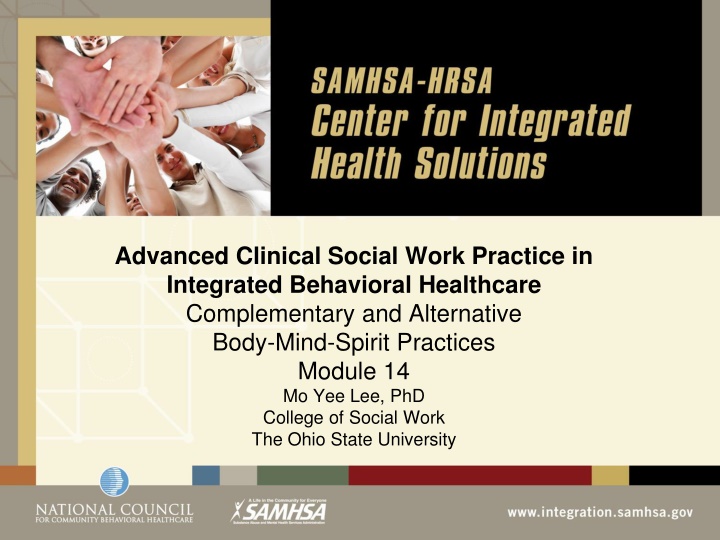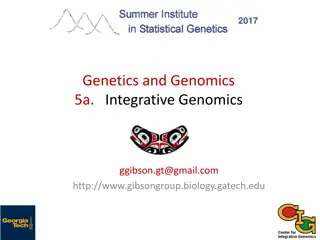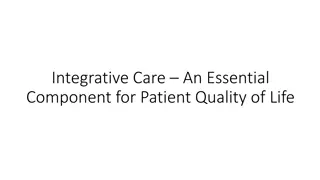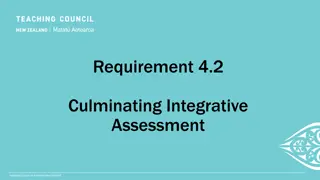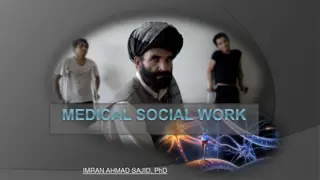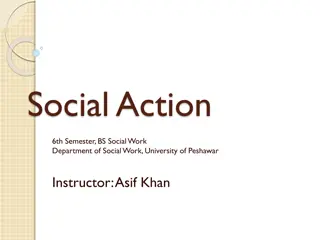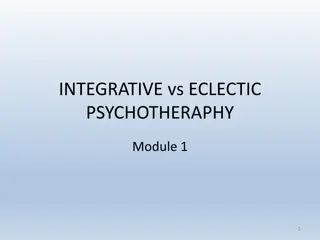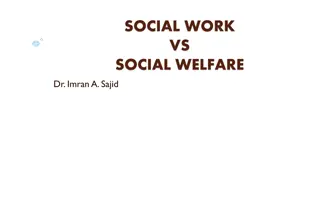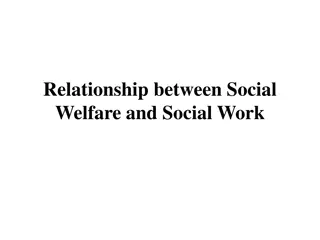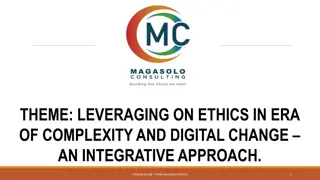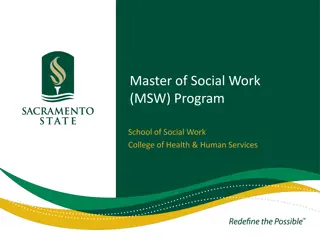Integrative Approaches in Clinical Social Work Practice
Explore the integration of Complementary and Alternative Medicine (CAM) with conventional healthcare in clinical social work practice. Gain knowledge on CAM practices, mindfulness, ethical considerations, and promoting wellness for clients and self-care. Understand the definition of integrative health services and the significance of integrating various modalities for holistic well-being.
Download Presentation

Please find below an Image/Link to download the presentation.
The content on the website is provided AS IS for your information and personal use only. It may not be sold, licensed, or shared on other websites without obtaining consent from the author.If you encounter any issues during the download, it is possible that the publisher has removed the file from their server.
You are allowed to download the files provided on this website for personal or commercial use, subject to the condition that they are used lawfully. All files are the property of their respective owners.
The content on the website is provided AS IS for your information and personal use only. It may not be sold, licensed, or shared on other websites without obtaining consent from the author.
E N D
Presentation Transcript
Advanced Clinical Social Work Practice in Integrated Behavioral Healthcare Complementary and Alternative Body-Mind-Spirit Practices Module 14 Mo Yee Lee, PhD College of Social Work The Ohio State University
Module 14: Complementary and Alternative Body-Mind-Spirit Practices Outline Obtain knowledge and understanding of CAM and body-mind- spirit health/mental health approaches and strategies for incorporating these treatment approaches in integrated health Develop initial skills in CAM body-mind-spirit (B/M/S) techniques that can be used with clients and for self-care Meditative practices and mindfulness Promoting wellness Ethical considerations for using CAM body-mind-spirit practices in integrated health
Integrative Medicine The National Center for Complementary and Alternative Medicine was established by the US Congress in 1998 as one of the twenty-seven institutes and centers that make up the National Institutes of Health. The Foundation for Integrative Medicine, founded by Dr. Andrew Weil American Holistic Medical Association The journals Alternative Therapies in Health and Medicine and Integrative Medicine provide professional forums for the advancement and dissemination of knowledge
Definitions National Center for Complementary and Alternative Medicine (CAM)1: CAM as a group of diverse medical and health care systems, practices, and products that are not generally considered part of conventional medicine. "Complementary medicine" refers to use of CAM together with conventional medicine. "Alternative medicine" refers to use of CAM in place of conventional medicine. "Integrative medicine" combines treatments from conventional medicine and CAM for which there is some high-quality evidence of safety and effectiveness. It is also called integrated medicine.
Definitions (Contd) Integrative health services refers to a broad domain of resources that encompasses health systems, modalities, and practices and their accompanying theories and beliefs, other than those intrinsic to the dominant health system of a particular society or culture in a given historical period. 2 CDC reports over 1/3 of the US population used some type of CAM interventions. Including meditation, spirituality and religious practices makes this number well over 2/3
Development of conventional social work practice A legitimate and secular substitution to address human problems of living when people no longer choose to use the traditional, communal, religious way of healing Values of scientificism, rationalism, humanism, individualism, etc contribute to: Demystify the treatment process Develop empirical-based practice Expand our understanding of humankind as biological, psychological and social beings Regulate unethical healing practices of all kinds Individualistic and humanistic thinking emancipates some people from years of traditional collective existence, sacrifices, and social injustice.
The Paradox of partial truths Values of scientificism, rationalism, individualism, humanism help advance social work profession in its practice BUT by separating behavioral treatment in social work practice from other domains, the development also becomes un-balanced
The shadow of modern social work practice A narrow and limited view of mind A narrow and limited view of body Missing spirituality Disconnected view of a person, service delivery, etc A limited view of self
A narrow interpretation of mind and body Mind: Only focus on the Rational mind (e.g., conventional cognitive approaches) Body: Only focus on observable and physical behaviors but not bodily experiences Downplay of the body process Behavioral approaches emphasize primarily observable and measurable behaviors Consequence of the Cartesian dualistic doctrine and Descartes' view of the self as a purely thinking being
Downplay of spirituality Social work should be objective and value-free Concept of spirituality is too vague to be consistent with a scientific professional base for social work practice, knowledge, research Religion or spirituality addresses ideas of supernatural or private experiences that should not be brought into the public domain of social work agencies Religions can be dogmatic, rigid, oppressive, and judgmental, which may violate the client s self- determination
A disconnected view of person and services, etc Psychosomatic describes processes involving both mind and body, and it carries a negative connotation A number of treatment models view cognitive, behavioral, and affective domains as distinctively separate (but interconnected in some ways). E.g., Cognitive therapy, behavioral therapy, emotion processing therapy Traditional separation of Health, Mental health and Addiction fields
The view of Self Self is viewed as an autonomous, independent entity that constitutes the center of change in the search for individual well-being, self-fulfillment, personal growth, and self-actualization The self is not just the vehicle for change but also contains the solution to problems of living
Problems with such a view of self The Problem of a Forever Actualizing Self Self as an autonomous, independent entity that exists separately This boundary around the self, while creates a sense of self-identity for individuals, also leads to polarities, oppositions, and conflicts Self as Containing Solutions to Problems of Living So much of our present-day problems relate to the self being disconnected, disjointed, and scattered Cultural critics speak of a larger self: a self that is connected to others, to our community, and to our environment
A small act of balance: Integrative Body- Mind-Spirit social work practice Reintroduce an integrative, network-oriented system of thought and practice to current social work practice A network-oriented and holistic view provides for a beneficial and alternative perspective for social work professionals to expand current social work practice and utilize body, mind, and spirit techniques in the treatment process
Integrative Body-Mind-Spirit practice is about: Building upon existing social work practice and knowledge Integrating a holistic perspective Addressing challenges and dilemmas encountered by social work practice in the twenty-first century Developing treatments that are effective, empirically- based, and consistent with a holistic view of being Demystifying body-mind-spirit social work practice
Defining Characteristics Recognition of body, mind, and spirituality as fundamental domains of human experience Equally use them in creating positive changes in people Recognition that everything is connected Interconnectedness of Body, Mind, and Spirit Interconnectedness of the person with their environment Appreciation of diverse forces and balance in life Attain or regain BALANCE instead of removing presenting problems as treatment goal Recognize strengths in problems and shadows in positives
Defining Characteristics (Contd) Embracing change Change and movement, as created by a dynamic balance of diverse forces of life, facilitates development and growth Strengths-based A belief that each individual or system has the potential and resources to solve their problems and be well
CAM Body-Mind-Spirit Interventions Spirit Patient/ Client Body Mind
Examples of CAM Body Techniques Exercise Nutrition including dietary supplements and homeotherapy Adequate sleep Mindful breathing/Meditation Body scan Yoga, Tai chi, Qigong, etc Spinal manipulation Massage Acupuncture Acupressure Dance and movement therapy
Cautions in using CAM Body Techniques Certain body techniques, e.g., acupuncture, spinal manipulation, can only be performed by licensed medical professionals Use of certain dietary supplements may not be compatible with conventional treatment St. John s wort should be be taken in combination with antidepressants Important to help clients to be critical and careful in choosing CAM practices on diet for diverse health and mental health problems Encourage clients to communicate and consult with their doctors or psychiatrists when using CAM practices on diet
Examples of techniques that focus on the mind Conventional cognitive techniques Meditative practices including mindfulness practices Guided or visual imagery Keep positive thinking and attitudes Be creative and curious about life Appreciation Accept changes Embrace suffering
Essence of Spirituality Provide opportunity to explore practices that enhance quality of life that relate to a person s personal lifestyle whether they be formal or informal Formal religious and or cultural practices Informal or formal introspective practices
Treatment goals of Spiritual interventions Enhancing Growth through Working with Problems and embracing pain/suffering Meaning Making Promoting Resilience and Affirming Inner Strength
Examples of techniques that focus on spirituality Medicine wheel Forgiveness therapy Meaning-making techniques: Re-authoring Life Narrative3 Reflection on life and experiences through journaling or other self-reflective activities Connectedness with higher power: e.g., Praying, meditation (e.g, Loving kindness meditation and Compassion meditation)
Examples of existing applications Depression4 Anxiety5 Trauma/PTSD6,7 Substance abuse8 Self-care of professionals9 Pain management10 Stress management11
Meditation Meditation is a set of practices that have been around for more than 4,000 years, with roots in Buddhism, Ayurveda, and other contemplative traditions such as Catholicism Two distinctive intentions associated with meditation practice: Expand awareness of the moment-to-moment existence Cultivate an attitude of love and compassion in encountering life and the world
Mindfulness A type of meditative practice Mindfulness describes a quality of consciousness that is characterized by enhanced attention to and awareness of current experience or present reality as it is
Theoretical Foundations of mindfulness and meditative practices as complementary behavioral interventions Neurobiological effects Self-determination theory Systems perspective
Systems perspective Describe how the self-regulation process occurs through the operation of feedback mechanisms Feedback processes are inherently self-corrective and self-regulating mechanisms that enable the system to sustain itself in a functional way Attention to internal and external stimuli constitutes the necessary input for a person to initiate the self- regulating feedback processes
Self-Determination Theory12 Deci and Ryan (1980) posits that open awareness is essential in facilitating the choice of behaviors that are consistent with one s needs, values, and interests Awareness facilitates attention to prompts arising from basic needs, making a person more likely to regulate behavior in a way that fulfills personal needs
Neurobiological effects of meditation: The Relaxation Response Meditation is a stress-reducing phenomenon that brings about the relaxation response by inducing favorable brain waves and decreasing physiological effects of stress, such as: lowered respiration rate decreased heart rate lowered blood pressure. increase in blood oxygen saturation levels
Positive Benefits of Meditation Enhance a person s ability to stay physiologically calm Foster a person s capacity to recognize and attend to current experiences Enhance a person s self-regulating abilities so they make choices that are responsive and beneficial to their current needs and situations
Promoting Wellness Spiritual wellness Physical wellness Emotional wellness Intellectual wellness Social wellness Occupational wellness
Defining Wellness Wellness is an active process through which people become aware of, and make choices toward, a more successful existence13 Multidimensionality: Wellness is not just one aspect of a person s life but covers multiple areas that work together to create a whole individual Active process: Becoming well is a process that occurs over time and is self-directed via self-care activities Positive and supportive nature of the concept
Ethical guidelines for selecting complementary and alternative body-mind-spirit techniques Respect for Self-Determination Effectiveness in Treating Clients Safety Non-Intrusive Self-Administrable Simple, Easy and Quick to master Culturally Appropriate and Sensitive
Useful websites: National Center for Complementary and Alternative Medicine NCCAM Centre on Behavioral Health, University of Hong Kong CBH Healthy Coping With Stress Inner Health Studio Buddhist inspired resources for physicians and other health care professionals Dharma Doctors
References 1. National Center for Complementary and Alternative Medicine (July 2011). What is Complementary and Alternative Medicine? Retrieved from http://nccam.nih.gov/health/whatiscam September 17, 2012. 2. Gant, L. M., Benn, R., Gioia, D., & Seabury, B. (2009). Incorporating integrative health services in social work education. Journal of Social Work Education, 45(3), 405-425. 3. Neimeyer, R. A. (2006). Narrating the dialogical self: Toward an expanded toolbox for the counselling psychologist. Counseling Psychology Quarterly, 19(1),105-120. 4. Teasdale, J. D., Segal, Z. V., Williams, J. M. G., Ridgeway, V. A., Soulsby, J. M., & Lau, M. A. (2000). Prevention of relapse/recurrence in major depression by mindfulness-based cognitive therapy. Journal of Consulting and Clinical Psychology, 68, 615-625. 5. Kabat-Zinn, J., Massion, A. O., Kristeller, J., Peterson, L. G., Fletcher, K. E., Pbert, L., et al. (1992). Effectiveness of a meditation-based stress reduction program in the treatment of anxiety disorders. American Journal of Psychiatry, 149, 936-943. 6. Lee, M. Y.,Zaharlick, A., Akers, D. (2011). Meditation and Treatment of Female Trauma Survivors of Interpersonal Abuses: Utilizing Clients Strengths. Families in Society, 92(1), 41-49 7. van der Kolk, B. A. (2002). The assessment and treatment of complex PTSD. In R. Yehuda (Ed.), Treating Trauma Survivors with PTSD (pp. 127-156). Washington, D C: American Psychiatric Press. 8. Witkiewitz, K., Marlatt, G. A. ,& Walker, D. (2005). Mindfulness-Based Relapse Prevention for Alcohol and Substance Use Disorders. Journal of Cognitive Psychotherapy: An International Quarterly, 19, 211-228. 9. Krasner M., S, Epstein R., M, Beckman H. Suchman A., L, Chapman B. Mooney C., J, Quill, T.E. (2009) Association of an educational program in mindful communication with burnout, empathy, and attitudes among primary care physicians, JAMA. Sep 23; 302(12): 1284-93.
References (Contd) 10. Kabat-Zinn, J., L. Lipworth, and R. Burney (1985). The clinical use of mindfulness meditation for the self-regulation of chronic pain. Journal of Behavioral Medicine 8:162 90. Napoli, M. (2011). Tools for mindful living: Stepping stones for practice and CD. Dubuque, IA: Kendall Hunt Publishing Company. Deci, E. L., & Ryan, R. M. (1980). Self-determination theory: When mind mediates behavior. The Journal of Mind and Behavior, 1, 33-43. National Institute of Wellness. Retrieved from http://www.nationalwellness.org/index.php?id_tier=2&id_c=26 on September 25, 2012. 11. 12. 13.
